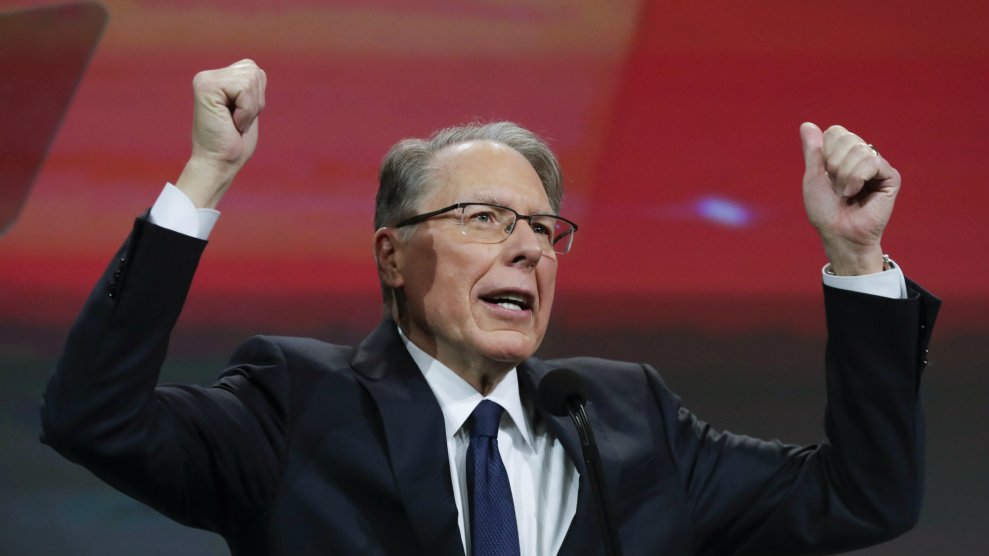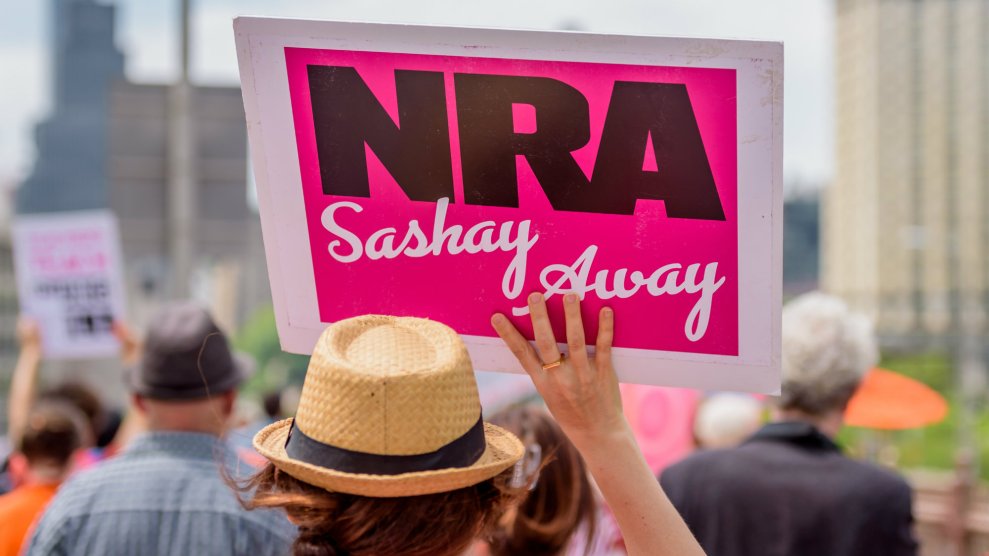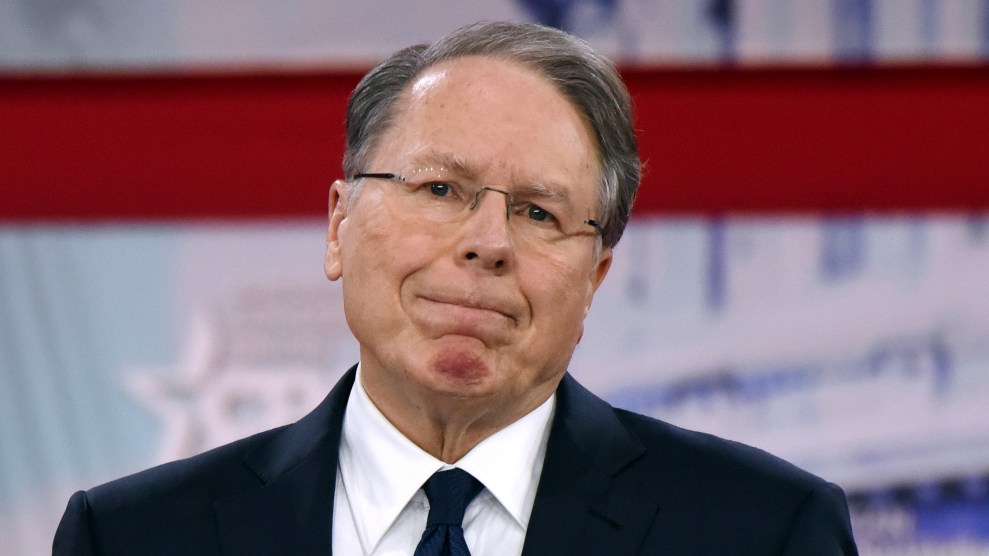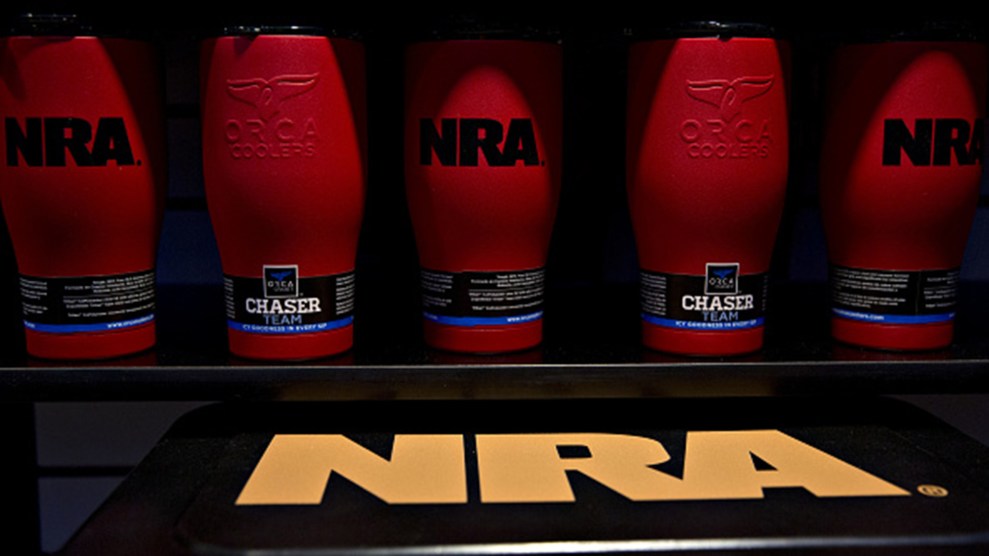
AP/Michael Conroy
Last week, three members of the National Rifle Association’s 76-member board of directors resigned from their positions. That might seem like small potatoes for the nation’s leading gun rights group, but considering the dire financial situation and multi-pronged legal turmoil the NRA is in these days, it’s a sign that the worst may be yet to come.
In a letter sent to NRA officials, and later obtained by the Washington Post, the three board members—Esther Schneider, Sean Maloney, and Timothy Knight—announced their decision by writing that “while our belief in the NRA’s mission remains as strong today as ever, our confidence in the NRA’s leadership has been shattered.”
Those are strong words to describe what’s been going on behind-the-scenes at the nation’s leading gun rights group: eyebrow-raising spending habits—especially by and for NRA chief executive Wayne LaPierre—that show an exorbitant flow of money to the NRA’s leadership. And this comes at a time when the organization is hemorrhaging cash, struggling to keep members, and is embroiled in several scandals, including dual investigations by state attorneys general and possible ties to Kremlin-linked Russian operatives.
All this is happening at a time when the 2020 presidential race is just starting to kick into high gear. For decades, the NRA has been an influential force in American politics, spending millions of dollars to promote the GOP’s agenda. That role had never been more prominent as it was during the 2016 election, in which the group spent a record $54.4 million to help elect Donald Trump and Republican candidates running for US Senate seats. In the most recent Democratic presidential debates, nearly every candidate agreed that one of best ways to move the needle on gun control issues was to get the NRA’s money out of elections. And as the debate around passing gun control legislation flares up again in the wake of the most recent mass shootings in El Paso, Texas, Dayton, Ohio, and Gilroy, California., many Democratic politicians are once again calling attention to, and questioning, the NRA’s role in the country’s gun violence crisis.
Here’s everything you need to know about the NRA’s numerous money problems, scandals, and investigations that has led to these board member resignations, and could affect its influence in 2020 elections.
2016 Ramp Up of Political Spending
To really understand the NRA’s current troubles, you have to look at the historic amount of money it spent in the 2016 election. Though the NRA originally started in the tail-end of the 19th century as a membership group solely focused on educating its members about firearm safety and related legislation, in the past century the NRA has evolved into a powerful lobbying force. Through the NRA Institute for Legislative Action—its lobbying arm, which manages its political action committee, the Political Victory Fund—the group has spent hundreds of millions of dollars over decades to help elect Republican politicians.
The group’s biggest political gamble was the $30.3 million it spent to get Donald Trump elected. As OpenSecrets reported, that figure “was more than any other outside group” in terms of support for a single candidate that year, and more than twice what the NRA spent to support Mitt Romney in his 2012 presidential campaign against Barack Obama. In the 2016 election, the group used the bulk of its money to flood radio and television stations with ads targeted at potential Trump voters. “We saw through the media deception, and recognized him for who he was: the most openly pro-Second Amendment presidential candidate in history,” LaPierre said in a video address to NRA members shortly before Trump’s inauguration.
Elsewhere in 2016, the NRA injected $20 million into six Senate races—including Richard Burr in North Carolina, Marco Rubio in Florida, and Roy Blunt in Missouri. All but one—Republican Joe Heck’s campaign to fill the Nevada Senate seat left vacant by Harry Reid’s retirement—were successful. In all, the NRA spent $54.4 million on national elections that year, which accounted for just over 12 percent of the record $412 million total operating budget in 2016. It was a financial gamble that proved successful, but it also cost the NRA a ton of money: the group closed out 2016 at about $46 million in the red, according to a 2017 audit of its finances—a hefty contrast to the $27.8 million surplus it reported in 2015.
Infighting Turns Public
While the NRA’s titanic spending in 2016 was a political success, it was a lot more than its revenue, and the group had to make tough cuts to get out of the red. But despite publicly pinching pennies, recent reports of extravagant spending by its top brass—namely LaPierre, the NRA’s long-running unapologetically outspoken leader—have plagued the organization. During its annual meeting in April, drama unfolded when former NRA President Oliver North—a retired Marine Corps lieutenant colonel who most famously was at the center of President Ronald Reagan’s Iran-Contra scandal—resigned, allegedly a forced move after he threatened to leak documents (which he ended up doing) to expose LaPierre’s lavish spending on wardrobe and travel on the NRA’s dime (on top of his $1.4 million annual salary). Since North’s letter leaked, further reporting shed light on just how much money the NRA was excessively spending by and for its leadership—and the internal fallout continues to snowball. In June, Chris Cox, the NRA’s top lobbyist and its second-in-command, was ousted because of his alleged complicity in the failed coup of LaPierre. The Washington Post reported that many of the NRA board members were receiving hundreds of thousands of dollars while working to steer the group’s finances:
A former pro football player who serves on the National Rifle Association board was paid $400,000 by the group in recent years for public outreach and firearms training. Another board member, a writer in New Mexico, collected more than $28,000 for articles in NRA publications. Yet another board member sold ammunition from his private company to the NRA for an undisclosed sum.
And, most recently, the Post reported that the NRA was considering buying a $6 million mansion for LaPierre and his family last year in the aftermath of the mass shooting at the Marjory Stoneman Douglas High School in Parkland, Florida.
All this comes after LaPierre sent his own letter to the NRA’s board of directors claiming that North and Ackerman McQueen, the organization’s longtime public affairs firm for nearly four decades, were conspiring to oust him. Why? Because of a bitter lawsuit filed by the NRA against Ackerman McQueen that claims the PR firm liberally overcharged them for millions of dollars for services, in particular related to the failed NRATV. In a letter to the NRA board delivered just when the group’s April meeting was kicking off, LaPierre alleged that North was receiving millions of dollars from Ackerman McQueen, which itself was receiving millions of dollars from the NRA. In short, vast sums of money from the NRA funneled right back into the pockets of one of its president, according to LaPierre.
And this all happened after the New Yorker and The Trace co-published a joint investigation about the organization in mid-April that explains how “a small group of NRA executives, contractors and vendors has extracted hundreds of millions of dollars from the nonprofit’s budget, through gratuitous payments, sweetheart deals, and opaque financial arrangements.”
All together, the palace intrigue reports of the NRA’s sticky financial situation should be more than enough to send numerous red flags to the IRS to investigate its tax-exempt status (but that likely won’t happen). But it has drawn the attention of both the New York State and DC attorneys general.
Budget Troubles
After Trump was elected to office—along with another GOP-controlled Congress—the NRA’s revenue began to decline. More than half of the NRA’s revenue comes from its dues-paying members, In 2016, that accounted for nearly $164 million of its total revenue of $433.9 million, which according to a financial statement distributed to its members in 2017, consolidates the revenue and expenses of all six of its affiliated organizations.
But between 2016 and 2017, the group’s revenue from membership dues dropped from just under $164 million to $128 million. Additionally, outside contributions from individuals and major donors dropped in the first year of Trump’s presidency—from $125 million to $98 million—resulting in a total income decrease of $55 million in 2017. It’s not entirely surprising that the NRA’s revenue from membership dues and contributions dropped after Trump took office: As Vox points out, “with no threat to gun rights currently in the offing, the surge in gun purchases that likely would have taken place if Hillary Clinton had won the presidency didn’t happen,” thus making it harder for the NRA to scaremonger for donations.
Things got a little better in 2018: As the Washington Post reported, membership revenue grew to $170 million, and the total amount of money the organization and its affiliates—which includes its PAC, the NRA Political Victory Fund, and its four charitable arms—brought in was $412 million, exceeding its total revenue of $378 million in 2017.
Still, despite the revenue increase in 2017, the NRA has continued to spend more than it has made since Trump took office, digging itself into a deep financial hole that’s caused rifts within the organization. In 2017, the NRA and its affiliates spent $379 million and in 2018 it spent $423 million—compared to the $378 million and $412 million it raised, respectively. That financial pitfall was on full display during the 2018 midterm elections, in which the NRA had a significantly reduced influence than the 2016 election: the group spent only $9.5 million to support Republican candidates, less than it had spent in past midterm elections. That number was so low that, for the first time in recent memory, political groups in favor of additional gun control actually outspent the NRA in an election.
As a result, the NRA has tried to cut costs in a number of areas. According to its most recent financial report, which was distributed at its annual meeting in April, between 2017 and 2018 the group cut spending in public affairs by 12 percent and costs related to gun safety, education, and training by 23 percent—for a total of more than $15 million. Elsewhere, the group saved dollars where it could to make ends meet, like no longer providing free coffee and water for employees. And at the end of 2018, the NRA froze its employee’s pension plans, which saved about $13 million. It also borrowed against its Fairfax, Virginia headquarters to obtain a $28 million line of credit.
Resignations and Looming Investigations
Given all this, it’s no surprise that both New York State attorney general Laetitia James and DC attorney general Karl Racine are investigating the NRA’s finances.
In a statement provided to Mother Jones last month, Racine’s office said it has issued subpoenas for financial documents from both the NRA and its charitable foundation, “as part of an investigation into whether these entities violated the District’s Nonprofit Act.” Meanwhile in the New York attorney general’s probe into the NRA’s finances, which was launched in April after North’s letter leaked, James issued a subpoena earlier this week “seeking documents from more than 90 current and former members of the organization’s board,” the New York Times reports.
This all could amount to writing on the wall for the NRA’s demise, and in particular, its board of directors. At least that’s what Schneider, Maloney, and Knight alluded to in their resignation letter:
Over the past several months, there have been numerous, highly- publicized allegations of impropriety leveled against the Association and certain members of its executive leadership team. In exercising our oversight responsibilities as Board Members, we have sought information and requested certain actions be taken with respect to these allegations, only to be rebuffed at every turn.
















